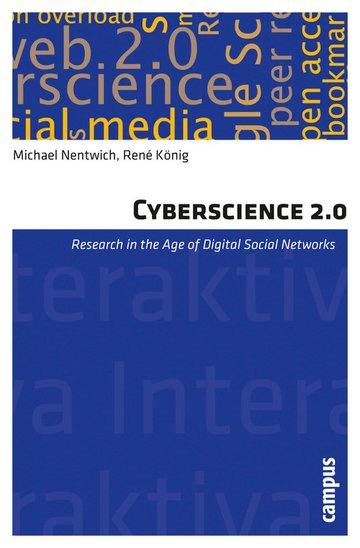| Contents | 6 |
| Preface | 10 |
| 1 Introduction | 12 |
| 1.1 Cyberscience 1.0 Revisited | 13 |
| 1.2 Web 2.0 and Cyberscience | 16 |
| 1.2.1 The Internet is becoming a social space | 16 |
| 1.2.2 Social media, digital social networks and digital social culture | 18 |
| 1.2.3 On the path to cyberscience 2.0? | 20 |
| 1.3 Conceptual Framework and Methods | 22 |
| 1.3.1 Modeling scholarly activities and ICT impact on academia | 22 |
| 1.3.2 Methods applied | 26 |
| 2 Case Studies | 28 |
| 2.1 Social Network Sites | 30 |
| 2.1.1 Main functions | 37 |
| 2.1.2 Potential for science and research | 44 |
| 2.1.3 Usage practices and impact | 46 |
| 2.1.4 Interim conclusions | 59 |
| 2.2 Microblogging | 61 |
| 2.2.1 Main functions | 62 |
| 2.2.2 Potentials for academia | 65 |
| 2.2.3 Usage practices and impact | 68 |
| 2.2.4 Interim conclusions | 81 |
| 2.3 Collaborative Knowledge Production—The Case of Wikimedia | 83 |
| 2.3.1 Main functions and core principles | 85 |
| 2.3.2 Potentials for academia | 93 |
| 2.3.3 Usage practices and impact | 96 |
| 2.3.4 Interim conclusions | 108 |
| 2.4 Virtual Worlds—The Case of Second Life | 111 |
| 2.4.1 Main functions | 112 |
| 2.4.2 Potentials for science and research | 114 |
| 2.4.3 Usage practices and impact | 115 |
| 2.4.4 Interim conclusions | 123 |
| 2.5 Search Engines—The Case of Google | 124 |
| 2.5.1 Main functions | 127 |
| 2.5.2 Potential for academia | 136 |
| 2.5.3 User practices and impact | 138 |
| 2.5.4 Interim conclusions | 150 |
| 3 Cross-Cutting Analysis | 154 |
| 3.1 Interactivity as a Crucial Category | 154 |
| 3.1.1 Utopian and dystopian perspectives | 154 |
| 3.1.2 Insiders and outsiders: methodological issues | 157 |
| 3.1.3 Overcoming the barriers between utopians and dystopians | 160 |
| 3.2 New Windows in the Ivory Tower | 162 |
| 3.2.1 Bringing together the academic and the public sphere | 163 |
| 3.2.2 Blurring media formats | 166 |
| 3.2.3 Blurring roles | 169 |
| 3.2.4 Bridging the boundaries? | 172 |
| 3.3 Academic Quality and Digital Social Networks | 174 |
| 3.3.1 Recent developments in academic quality control | 174 |
| 3.3.2 Ex ante quality control for or through digital social networks? | 176 |
| 3.3.3 Ex post quality control in digital social networks | 179 |
| 3.3.4 Crediting and incentives | 182 |
| 3.4 Information Overload or Information Paradise? | 183 |
| 3.4.1 The evolution and diversification of communication channels in academia | 184 |
| 3.4.2 Quantitative impacts of multi-channel communication | 187 |
| 3.4.3 Qualitative impacts? | 189 |
| 3.5 Between Transparency and Privacy | 192 |
| 3.5.1 Privacy versus transparency in the Web 2.0 | 193 |
| 3.5.2 Privacy impact assessment of academic use of social media | 194 |
| 3.5.3 Paths towards transparent and privacy-friendly academic Web 2.0? | 196 |
| 3.6 Towards Democratization of Science? | 199 |
| 3.6.1 What does democratization mean? | 199 |
| 3.6.2 Internal democratization? | 201 |
| 3.6.3 External democratization? | 205 |
| 3.6.4 Obstacles for assessing democratization processes | 208 |
| 4 Overall Conclusions and Outlook | 210 |
| 4.1 Maturing Cyberscience | 210 |
| 4.2 The Cyberscience 2.0 Prospects | 212 |
| 4.3 An Ambivalent Overall Assessment | 216 |
| Abbreviations | 218 |
| List of Tables | 220 |
| List of Figures | 221 |
| Bibliography | 222 |
| Index | 244 |

















